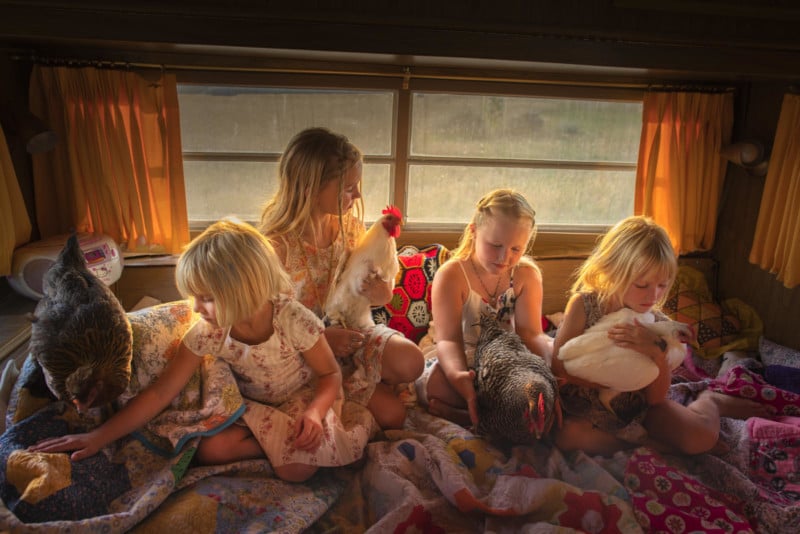Portraits of Americans in the Intimacy of Their Bedrooms
![]()
Photographer Barbara Peacock began capturing strangers in their bedrooms, eventually developing the project into an in-depth portrait of American people today.
A Glimpse Into the Lives of Americans
Six years ago, Peacock — based in Portland, Maine — started a social photo project, “American Bedroom“. The idea was simple — create unguarded portraits of people in their own environments. After six months of shooting, Peacock started asking her subjects for personal statements, which soon turned the photography project into a more comprehensive insight into today’s American society.
![]()
![]()
![]()
“When Pepere, an 88-year widower, said ‘when I wake up in the morning I try to be quiet, then I realize she is no longer here,’ it was upon hearing that I had an epiphany that the statements were an intrinsic part, if not more important than the photographs,” Peacock tells PetaPixel.
“I feel as the project goes on, now into its sixth year, I am more like a conduit for the Americans I photograph. Their lives and stories are a tapestry of America at this time, so it is much bigger than me. I say that sincerely.”
Peacock approaches all participants in the same collaborative manner but has since introduced figurative paintings as a reference during the course of the project. She gathers them on her phone and shares them with her subject. Doing so also makes for a great way to break the ice and serves as a quick reference to see her subject’s aesthetic.
Connecting with the Subject
So far, Peacock’s journey with “American Bedroom” has been nothing short of “amazing,” she says. Once someone agrees to be photographed and welcome Peacock in their private space, that’s already “half the battle” won.
“Permission has been granted and they are opening the door,” Peacock explains. “I never try to twist someone’s arm into it. That just doesn’t work. It has to be mutual.”
“So, pretty much once the ‘yes’ has transpired the fun begins,” she continues. “Opening a door to a room is like opening a package. There are many unknowns and challenges, but that is what makes it so fascinating.”
![]()
![]()
![]()
![]()
![]()
As each individual varies, so does the actual shooting process. Overall, the session starts with a relaxed chat for both parties to get to know each better. Some who are more extraverted prefer to jump right into it while others need more time and for Peacock to patiently ease them into the session.
“Once they are comfortable we proceed to the bedroom,” Peacock says. “I take a look at the light, where is it coming from, how much is there and where I will position myself to make the best photo.”
“There are calculations to be made and while I am factoring these and other decisions I set up my tripod and keep the conversation flowing, light and friendly. We discuss clothing or the absence of it and who will be in the photo.”
![]()
![]()
![]()
After the “warm-up period” of checking exposure and the overall composition, people start to loosen up until eventually, they catch themselves having fun while Peacock photographs.
“Even my most nervous subjects say they had a great time and will remember it for a long time. The actual photography averages around 45 minutes to an hour. After we are all done I like to stay and chat if they want to,” Peacock says.
“Often we will break bread together,” she continues. “They may have cooked for me as was the case with the chicken girls’ mom, Jamie, in Idaho, or I take them out to eat as is often the case to simply express my gratitude.”

Peacock’s memories are filled with unforgettable and deeply personal moments experienced during the course of the project. From treating a special needs woman to a diner meal to providing company to those she felt needed it the most, to tracking down a 100-year-old lady who said no to having her photograph taken but invited Peacock into her home for a cup of iced tea and a beautiful sunset over her farm.
At times, the project and the people she meets along the way help Peacock reflect on life and learn more about herself, because “sometimes the photograph is not the most important thing.”
The Future of “American Bedroom”
Although the project has been underway for six years now, Peacock has a definite conclusion in mind — she aims to travel to all 50 states for the project to be finalized. She also has a publicist working on a book proposal to share with publishers.
The dream goes beyond a book — Peacock hopes to have a show that travels across the country, introducing the world to her intimate portrayal of Americans and their diverse lives.
![]()
![]()
![]()
“I hope people see the extraordinary in the ordinary,” she explains. “That every story and every human life is important.”
“It is my hope that the disparity of others’ lives, much different or unusual than our own, may be seen, truly seen and at the same time I hope people will recognize bits of themselves within the imagery concluding that as human beings we are truly more connected and alike than one might think.”
More of Peacock’s work can be found on her website and Instagram.
Image credits: Photos by Barbara Peacock.